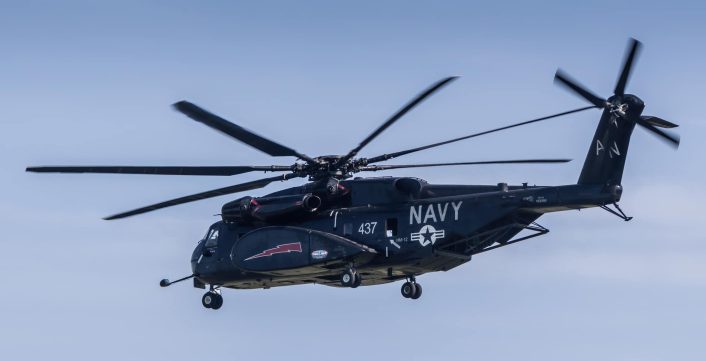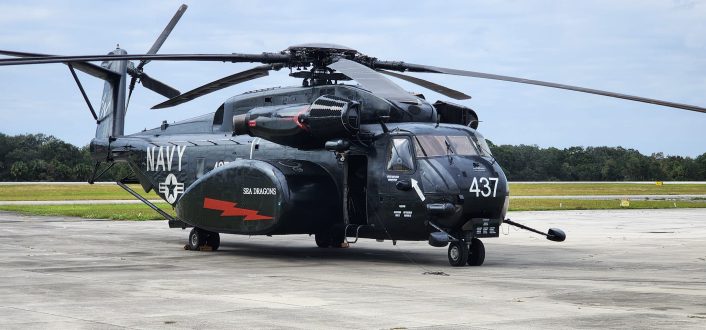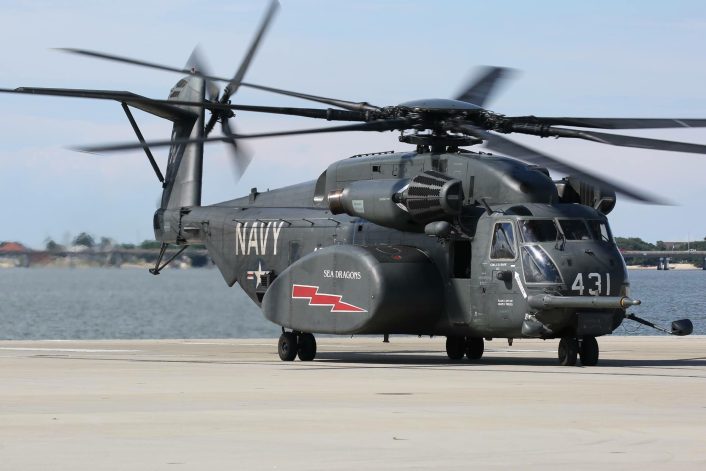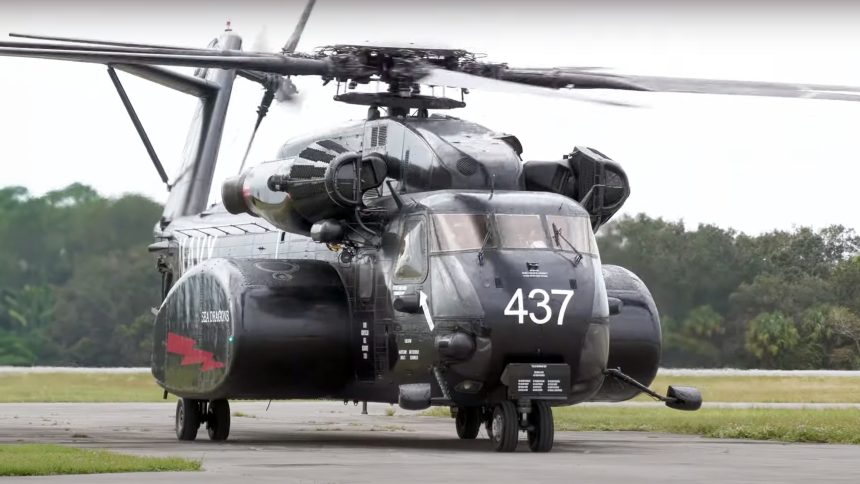HM-12 flew the MH-53E Sea Dragon 160633 “Dragon 437” to Titusville’s Warbird Museum. Its the first of its kind to be displayed in a museum.
On Oct. 16, 2024, Helicopter Mine Countermeasures Squadron (HM) 12 flew a special mission to Titusville, Florida, to officially transfer an MH-53E Sea Dragon helicopter to the Valiant Air Command Warbird Museum. This helicopter, which represents a significant chapter in the U.S. Navy’s history of airborne mine countermeasures (AMCM), will be permanently housed at the Warbird Museum, on loan from the National Naval Aviation Museum (NNAM).
“We’re thrilled to see this important part of the AMCM community’s legacy join the living history here at the museum,” said Capt. Eric Johnson, commanding officer of HM-12 in a public statement. “AMCM has been the career for many of us, and I’ve encouraged our Sailors to honor that legacy. For me, that means living up to the standards set by those who came before us in this community and the Navy as a whole.”
Hill Goodspeed, deputy director of the NNAM, explained the importance of partnerships with other museums to broaden the reach of naval aviation’s story. “When the National Naval Aviation Museum was founded in 1962, our mission was to collect, preserve, and display artifacts that reflect the rich heritage of naval aviation,” Goodspeed said. “Working with other museums helps us reach wider audiences and share these important stories.”
The arrival of the “Big Iron” to its new home was streamed live on YouTube and Facebook.
The ceremony surrounding the MH-53E’s induction celebrated its role in naval aviation and the long history of the Sea Dragon’s service. Col. Kate Fleeger, Program Manager for H-53 Heavy Lift Helicopters, highlighted the helicopter’s immense contributions over nearly four decades:
“The MH-53 has been a key part of the Navy’s airborne mine countermeasures mission for almost 40 years. But beyond that, it has also provided heavy-lift support for countless missions, from moving mail in the Persian Gulf to providing disaster relief around the world. It’s even been used for firefighting with specialized equipment.”
Founded in 1977, the Valiant Air Command Warbird Museum has grown into a significant collection of historic aircraft, with the MH-53E marking a milestone as the first of its kind to be displayed in a museum setting. While 28 of these helicopters remain in service today, the fleet is scheduled to start phasing out in 2025, with complete retirement planned for 2027.

Reflecting on the aircraft’s operational history, Capt. Johnson noted how crucial the MH-53E has been in both tactical logistics and strategic missions.
“It’s an incredible aircraft, and I feel honored to have flown it. What’s even more amazing is how our entire squadron came together to make this donation happen.”
Introduced in 1986, the MH-53E Sea Dragon has played a vital role in both mine countermeasures and heavy-lift operations, equipped with cutting-edge technology that allows it to detect and neutralize sea mines while also supporting logistics and humanitarian missions.
The Sea Dragon’s transfer to the museum also holds special meaning for veterans like Scott Webb, a former MH-53E aircrewman who is now an air traffic controller. Having grown up in Titusville, Webb reflected on how much this event meant to him personally.
“Seeing the Sea Dragon inducted into the same museum I’ve visited since I was a kid feels surreal,” Webb said. “It’s not just about seeing the aircraft on display—it’s about remembering the missions, the sacrifices, and the pride we took in what we did. It’s great to know that our story will live on and inspire future generations.”
Capt. Johnson closed the ceremony by emphasizing the lasting impact that naval aviation can have, inspiring young people to explore the opportunities military service can provide.

HM-12 Squadron History
Originally formed as Helicopter Combat Support Squadron SIX (HC-6) Detachment 53, Helicopter Mine Countermeasures Squadron TWELVE (HM-12) was officially established on April 1, 1971, at Naval Air Station Norfolk, Virginia. It was the first squadron of its type, serving both as an operational unit and as a training squadron focused on maintaining readiness.
After its creation, HM-12 was involved in several important military operations worldwide. In October 1972, a simulated minefield resembling those off the Haiphong Channel was set up near Panama City, Florida. In collaboration with the Naval Coastal Systems Laboratory (NCSL), HM-12 worked to develop tactics, techniques, and equipment for countering sea mines. In November of that same year, 13 helicopters from HM-12, along with around 450 personnel, were deployed for Operation ENDSWEEP. Their mission was to clear mines from North Vietnamese waters, harbors, and channels—an effort that significantly contributed to peace negotiations between the U.S. and North Vietnam. This mission also marked a key moment in naval aviation history, as it was the first time a live mine was detonated. Between 1974 and 1975, the squadron took part in mine-clearing operations in the Suez Canal and near the UAE as part of Operations NIMBUS STAR and NIMBUS STREAM. After these successful missions, HM-12 Detachment TWO was deployed to NAF Sigonella, Sicily, where they carried out vertical onboard delivery (VOD) operations in support of the U.S. Sixth Fleet.
In May 1978, HM-12 Detachment ONE and Mine Countermeasures Unit ALPHA were renamed HM-14, while Detachment TWO and Mine Countermeasures Unit BRAVO became HM-16. HM-12 continued providing vital fleet replacement training for the airborne mine countermeasures (AMCM) community, offering courses for pilots, aircrews, and maintenance personnel.
With the delivery of the Navy’s first CH-53E “Super Stallion” helicopters, HM-12 expanded its VOD operations, supporting carrier battle groups worldwide. Between 1983 and 1987, HM-12 “Hawlin Hogs” provided crucial fleet logistics support along the East Coast and in the Caribbean.
On May 28, 1987, HM-12 received its first MH-53E “Sea Dragon” helicopter, a major advancement in the Navy’s mine countermeasures capabilities. The Sea Dragon, with its superior technology, significantly enhanced the AMCM community’s effectiveness.
HM-12 continued its remarkable service until it was disbanded as a Fleet Replacement Squadron on September 30, 1994. By that time, the squadron had accumulated over 23 years of mishap-free operations, logging more than 75,000 flight hours, and had trained 768 pilots, 1,200 aircrew, and 11,900 maintenance personnel. After the squadron’s disbandment, the AMCM Weapon Systems Training School (AWSTS), along with HMT-302 and later HM-14, took over the responsibility of fleet replacement training from 1994 to 2015.
On October 1, 2015, HM-12 was reactivated, proudly continuing its legacy as one of the Navy’s most distinguished helicopter squadrons.










